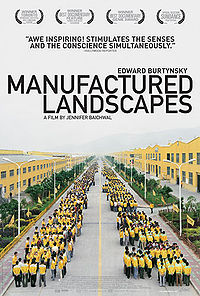 Manufactured Landscapes is one smart documentary. Let me count the ways: it manages to take us from beginning to end without a single on-screen sit down interview. It’s got a haunting, techy, glitchy original soundtrack. It manages to make a huge political statement without being preachy or even taking an overt position. But most of all, it’s simply breathtakingly to look at. I saw Jennifer Baichwal’s latest film at SIFF Cinema last fall, Act of God, and it’s also a visual orgasm.
Manufactured Landscapes is one smart documentary. Let me count the ways: it manages to take us from beginning to end without a single on-screen sit down interview. It’s got a haunting, techy, glitchy original soundtrack. It manages to make a huge political statement without being preachy or even taking an overt position. But most of all, it’s simply breathtakingly to look at. I saw Jennifer Baichwal’s latest film at SIFF Cinema last fall, Act of God, and it’s also a visual orgasm.
Synopsis: Canadian nature photographer Edward Burtynsky photographs the landscapes of the Earth that have been transformed by human activity to reveal a haunting picture of the modern world, and filmmaker Jennifer Baichwal weaves his pictures into a compelling visual poem.
Story Structure: A non-linear journey in which the filmmakers accompanied Burtynsky as he made his way around the world filming, from China to Bangladesh, intercut with current art exhibitions of photographs made on this trip. This overt playing with time combined with otherworldly soundtrack is like dreaming. The elements of story are provided without narration, with voiceover from the photographer who at no point is interviewed (although at one point is seen talking on stage explaining his work to an audience).
There’s also a rather strange sequence in the final third of the film in which a Shanghai real estate agent is essentially narrating the story of Shanghai. On balance, though, this is just brilliant filmmaking: eschewing traditional interviews in favor of endless, humongous images, in an open-ended meditation that leaves the viewer to draw her own conclusions.
Cinematography: In a word, HUGE. The opening sequence is an unforgettable 8-minute long tracking shot of a factory floor in China that assembles clothing irons. Reaching the end of the line the frame wipes to a still photo of the same factory floor, which then becomes the title of the film.
There’s a bunch of black and white footage in the film that was obviously shot by someone else – presumably they ran it in black and white to show that it was shot by someone other than the filmmakers. I did some googling and found out that another filmmaker, a rookie documentary filmmaker, had shot 80 hours of footage hoping to make a film, but Burtynsky wasn’t happy with the results, so he hooked up with Baichwal, who also hails from Canada.
There’s one dutch camera angle in the film that is a judicious use of the heavy-hammer technique: it’s used to show a container being lifted off a truck and hoisted onto a ship.
Editing: The way the editor linked the still photos to the moving pictures was sick. The first time this happens is with the shot of the workers lined up in front of the factory. It works like this: 1. shot of Burtynsky taking film out of his camera. 2. Still photo that results. 3. begin zooming out … and we realize that we’re in an art gallery as someone walks in front of the photo. All of this with J edits that had sound from one overlapping the next scene. Damn. That’s HOT.
In general Baichwal likes to use cuts that dissolve slowly into each other at different angles while the camera is traveling. For example, there’s a memorable dissolve between an angled tilt shot over a city scene from above, which is slowly dissolved into an oppositely angled tilt shot of a model city. She uses this type of edit a lot in Act of God, in which she’s tilting into treetops and cutting them together into a dreamy montage.
Music and Sound: Techy, glitchy, minimalist music is a perfectly discordant match for the pictures and images in the film. Some of it sounds like it was made from samples recorded at the scenes – jets of gas recur in music sounding like work on an assembly line. The way that found sounds creep into the edits is brilliant – for example, the “beep, beep” of the huge cranes at the port lifting containers off trucks and loading them onto container ships. You hear the beeping long before you see the crane making the sound, and I think it was in fact foly generated and then matched to the actual track because of background noise in the shot. Nicely done.
This film is an inspiration that I’ll be thinking about for a long time.